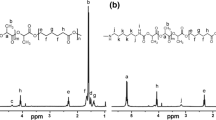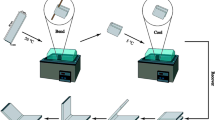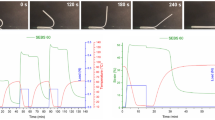Abstract
Biodegradable poly(lactide acid) (PLA) has been well-studied as a shape memory polymer in recent years, but the brittleness and relatively high Tg limit its applications. In this study, a series of PLA/poly(ethylene glycol) (PEG) blends were manufactured by using the solvent evaporation method. The thermal behaviors, morphology, hydrophilicity, and mechanical properties of the samples with different contents of PEG have been experimentally studied by differential scanning calorimetry, scanning electronic microscopy, water contact angle, dynamic mechanical analysis, and tensile test. Furthermore, the influence of PEG on the shape memory properties under different loading conditions including the stretch strain, recovery temperature, deformation temperature, and tensile rate were explored systematically. Experimental results reveal that introduction of appropriate contents of the plasticizer PEG into the PLA/PEG systems results in the significant improvement of morphology, hydrophilicity, and mechanical properties while the high shape memory properties are still retained.










Similar content being viewed by others
References
S-M. Lai, W-L. Wu, and Y-J. Wang: Annealing effect on the shape memory properties of polylactic acid (PLA)/thermoplastic polyurethane (TPU) bio-based blends. J. Polym. Res. 23, 99 (2016). https://doi.org/10.1007/s10965-016-0993-6
S. Cai, Y-C. Sun, J. Ren, and H.E. Naguib: Toward the low actuation temperature of flexible shape memory polymer composites with room temperature deformability via induced plasticizing effect. J. Mater. Chem. B 5, 8845 (2017). https://doi.org/10.1039/C7TB02068F
H. Lv, J. Leng, Y. Liu, and S. Du: Shape-memory polymer in response to solution. Adv. Eng. Mater. 10, 592 (2008). https://doi.org/10.1002/adem.200800002
M. Sabzi, M. Babaahmadi, and M. Rahnama: Thermally and electrically triggered triple-shape memory behavior of poly(vinyl acetate)/poly(lactic acid) due to graphene-induced phase separation. ACS Appl. Mater. Interfaces 9, 24061 (2017). https://doi.org/10.1021/acsami.7b02259
N. Khalili, H. Asif, and H.E. Naguib: Towards development of nanofibrous large strain flexible strain sensors with programmable shape memory properties. Smart Mater. Struct. 27, 055002 (2018). https://doi.org/10.1088/1361-665X/aab417
H. Xie, M.J. He, X.Y. Deng, L. Du, C.J. Fan, K.K. Yang, and Y.Z. Wang: Design of poly(L-lactide)–poly(ethylene glycol) copolymer with light-induced shape-memory effect triggered by pendant anthracene groups. ACS Appl. Mater. Interfaces 8, 9431 (2016). https://doi.org/10.1021/acsami.6b00704
B.K. Kim: Shape memory polymers and their future developments. EXPRESS Polym. Lett. 2, 614 (2008). https://doi.org/10.3144/expresspolymlett.2008.73
W. Xu, S. Wu, G.P. Balamurugan, M.R. Thompson, F.A. Brandys, and K.E. Nielsen: Evaluating shape memory behavior of polymer under deep-drawing conditions. Polym. Test. 62, 295 (2017). https://doi.org/10.1016/j.polymertesting.2017.07.009
J. Karger-Kocsis: Biodegradable polyester-based shape memory polymers: Concepts of (supra)molecular architecturing. EXPRESS Polym. Lett. 8, 397 (2014). https://doi.org/10.3144/expresspolymlett.2014.44
F.S. Senatov, M.Y. Zadorozhnyy, K.V. Niaza, V.V. Medvedev, S.D. Kaloshkin, N.Y. Anisimova, M.V. Kiselevskiy, and K-C. Yang: Shape memory effect in 3D-printed scaffolds for self-fitting implants. Eur. Polym. J. 93, 222 (2017). https://doi.org/10.1016/j.eurpolymj.2017.06.011
W. Zhao, L. Liu, X. Lan, B. Su, J. Leng, and Y. Liu: Adaptive repair device concept with shape memory polymer. Smart Mater. Struct. 26, 025027 (2017). https://doi.org/10.1088/1361-665X/aa5595
H. Wei, Q. Zhang, Y. Yao, L. Liu, Y. Liu, and J. Leng: Direct-write fabrication of 4D active shape-changing structures based on a shape memory polymer and its nanocomposite. ACS Appl. Mater. Interfaces 9, 876 (2017). https://doi.org/10.1021/acsami.6b12824
G.T. Carroll, J.R. Lancaster, N.J. Turro, J.T. Koberstein, and A. Mammana: Electroless deposition of nickel on photografted polymeric microscale patterns. Macromol. Rapid Commun. 38, 1600564 (2017). https://doi.org/10.1002/marc.201600564
H. Tsuji: Poly(lactide) stereocomplexes: Formation, structure, properties, degradation, and applications. Macromol. Biosci. 5, 569 (2005). https://doi.org/10.1002/mabi.200500062
C.M. Yakacki, R. Shandas R, C. Lanning, B. Rech, A. Eckstein, and K. Gall: Unconstrained recovery characterization of shape-memory polymer networks for cardiovascular applications. Biomaterials 28, 2255 (2007). https://doi.org/10.1016/j.biomaterials.2007.01.030
A. Gremare, V. Guduric, R. Bareille, V. Heroguez, S. Latour, N. L’Heureux, J.C. Fricain, S. Catros, and D. Le Nihouannen: Characterization of printed PLA scaffolds for bone tissue engineering. J. Biomed. Mater. Res., Part A 106, 887 (2018). https://doi.org/10.1002/jbm.a.36289
T.I. Hwang, B. Maharjan, A.P. Tiwari, S. Lee, M.K. Joshi, C.H. Park, and C.S. Kim: Facile fabrication of spongy nanofibrous scaffold for tissue engineering applications. Mater. Lett. 219, 119 (2018). https://doi.org/10.1016/j.matlet.2018.02.040
K. Wei, Y. Peng, Z. Qu, Y. Pei, and D. Fang: A cellular metastructure incorporating coupled negative thermal expansion and negative Poisson’s ratio. Int. J. Solids Struct. 150, 255 (2018). https://doi.org/10.1016/j.ijsolstr.2018.06.018
M.C. Tanzi, S. Bozzini, G. Candiani, A. Cigada, L. De Nardo, S. Fare, F. Ganazzoli, D. Gastaldi, M. Levi, P. Metrangolo, F. Migliavacca, R. Osellame, P. Petrini, G. Raffaini, G. Resnati, P. Vena, S. Vesentini, and P. Zunino: Trends in biomedical engineering: Focus on smart bio-materials and drug delivery. J. Appl. Biomater. Biomech. 9, 87 (2011).
X. Zhang, M.A. Geven, D.W. Grijpma, T. Peijs, and J.E. Gautrot: Tunable and processable shape memory composites based on degradable polymers. Polymer 122, 323 (2017). https://doi.org/10.1016/j.polymer.2017.06.066
W. Zhang, L. Chen, and Y. Zhang: Study on polylactide/poly(ether block amide) composite biomaterials and shape-memory effect. Mater. Sci. Forum 610–613, 1312 (2009). https://doi.org/10.4028/www.scientific.net/MSF.610-613.1312
S.K. Dogan, S. Boyacioglu, M. Kodal, O. Gokce, and G. Ozkoc: Thermally induced shape memory behavior, enzymatic degradation and biocompatibility of PLA/TPU blends: Effects of compatibilization. J. Mech. Behav. Biomed. Mater. 71, 349 (2017). https://doi.org/10.1016/j.jmbbm.2017.04.001
I. Navarro-Baena, V. Sessini, F. Dominici, L. Torre, J.M. Kenny, and L. Peponi: Design of biodegradable blends based on PLA and PCL: From morphological, thermal and mechanical studies to shape memory behavior. Polym. Degrad. Stab. 132, 97 (2016). https://doi.org/10.1016/j.polymdegradstab.2016.03.037
R.M. Rasal, A.V. Janorkar, and D.E. Hirt: Poly(lactic acid) modifications. Prog. Polym. Sci. 35, 338 (2010). https://doi.org/10.1016/j.progpolymsci.2009.12.003
I. Pillin, N. Montrelay, and Y. Grohens: Thermo-mechanical characterization of plasticized PLA: Is the miscibility the only significant factor? Polymer 47, 4676 (2006). https://doi.org/10.1016/j.polymer.2006.04.013
K.M. Choi, S.W. Lim, M.C. Choi, D.H. Han, and C.S. Ha: Properties of poly(ethylene glycol)-grafted poly(lactic acid) plasticized with poly(ethylene glycol). Macromol. Res. 22, 1312 (2014). https://doi.org/10.1007/s13233-014-2182-y
B.W. Chieng, N.A. Ibrahim, M.Z.Y. Wan, and M.Z. Hussein: Plasticized poly(lactic acid) with low molecular weight poly(ethylene glycol): Mechanical, thermal, and morphology properties. J. Appl. Polym. Sci. 130, 4576 (2013).
M. Bijarimi, S. Ahmad, R. Rasid, M.A. Khushairi, and M. Zakir: Poly(lactic acid)/poly(ethylene glycol) blends: Mechanical, thermal and morphological properties. AIP Conference Proceedings 1727, 020002 (2016). https://doi.org/10.1063/1.4945957
M. Barmouz and A. Hossein Behravesh: Shape memory behaviors in cylindrical shell PLA/TPU-cellulose nanofiber bio-nanocomposites: Analytical and experimental assessment. Composites, Part A 101, 160 (2017). https://doi.org/10.1016/j.compositesa.2017.06.014
W. Liu, R. Zhang, M. Huang, X. Dong, W. Xu, N. Ray, and J. Zhu: Design and structural study of a triple-shape memory PCL/PVC blend. Polymer 104, 115 (2016). https://doi.org/10.1016/j.polymer.2016.09.079
T. Shen, M. Lu, D. Zhou, and L. Liang: Influence of blocked polyisocyanate on thermomechanical, shape memory and biodegradable properties of poly(lactic acid)/poly(ethylene glycol) blends. Iran. Polym. J. 21, 317 (2012). https://doi.org/10.1007/s13726-012-0031-4
T. Goryczka and B. Szaraniec: Characterization of polylactide layer deposited on Ni–Ti shape memory. J. Mater. Eng. Perform. 23, 2682 (2014). https://doi.org/10.1007/s11665-014-1038-0
T. Phaechamud and S. Chitrattha: Pore formation mechanism of porous poly(DL-lactic acid) matrix membrane. Mater. Sci. Eng., C 61, 744 (2016).
M. Baiardo, G. Frisoni, M. Scandola, M. Rimelen, D. Lips, K. Ruffieux, and E. Wintermantel: Thermal and mechanical properties of plasticized poly(l-lactic acid). J. Appl. Polym. Sci. 90, 1731 (2003).
N. Cai, Q. Dai, Z. Wang, X. Luo, Y. Xue, and F. Yu: Preparation and properties of nanodiamond/poly(lactic acid) composite nanofiber scaffolds. Fibers Polym. 15, 2544 (2015).
ACKNOWLEDGMENT
The authors would like to sincerely thank the financial support from the National Natural Science Foundation of China (11502238 and 11372287), the International Science & Technology Cooperation Program of China (Grant No. 2015DFA30550), the China Postdoctoral Science Foundation (Grant Nos. 2016M592307 and 2017M610460), the Opening Fund of National Center for International Research of Micro-nano Molding Technology (MMT2017-05), and the International Science & Technology Cooperation Program of Henan (172102410076 and 173102410062).
Author information
Authors and Affiliations
Corresponding author
Rights and permissions
About this article
Cite this article
Guo, Y., Ma, J., Lv, Z. et al. The effect of plasticizer on the shape memory properties of poly(lactide acid)/poly(ethylene glycol) blends. Journal of Materials Research 33, 4101–4112 (2018). https://doi.org/10.1557/jmr.2018.359
Received:
Accepted:
Published:
Issue Date:
DOI: https://doi.org/10.1557/jmr.2018.359




